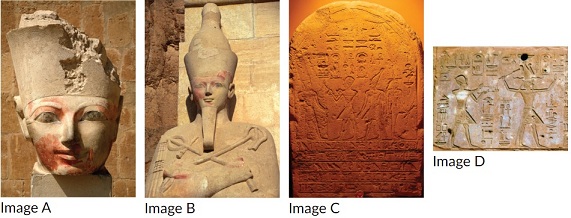Problem
The pharaohs of Egypt's New Kingdom were obsessed with self-representation and they carefully controlled their public images. The visual language they used was highly symbolic, an iconography (vocabulary of images) intended to make each successive pharaoh look as much like his royal predecessors as possible: godlike, steadfast, virile, authoritative-even when the pharaoh was a woman, Hatshepsut (1479-1458 b.c.e.). So many statues and portraits of her survive that nearly every major museum in the world has at least one (the Metropolitan Museum of Art in New York has a whole room set aside for them). But many of these images show signs of having been defaced during the reign of her successor, Thutmose III, who was also her nephew and stepson (images A and B). Until very recently, scholars assumed that Hatshepsut must have usurped his powers, and that this was his revenge. Yet the evidence clearly shows that Hatshepsut was Egypt's legitimate ruler. Why, then, would Thutmose III or his heirs have tried to efface to her memory? These two unblemished steles (images C and D) depict Hatshepsut and Thutmose III. In the stele on the left (image C), they sit back-to-back on matching thrones, under the protection of the gods. In the stele on the right (image D), Thutmose III wears a warrior's crown, while Hatshepsut wears the double crown of upper and Lower Egypt and wields a mace.
Question for Analysis:
What can these images tell us about gender roles? What else would we need to know before making a judgment about masculine and feminine characteristics in ancient Egypt?
